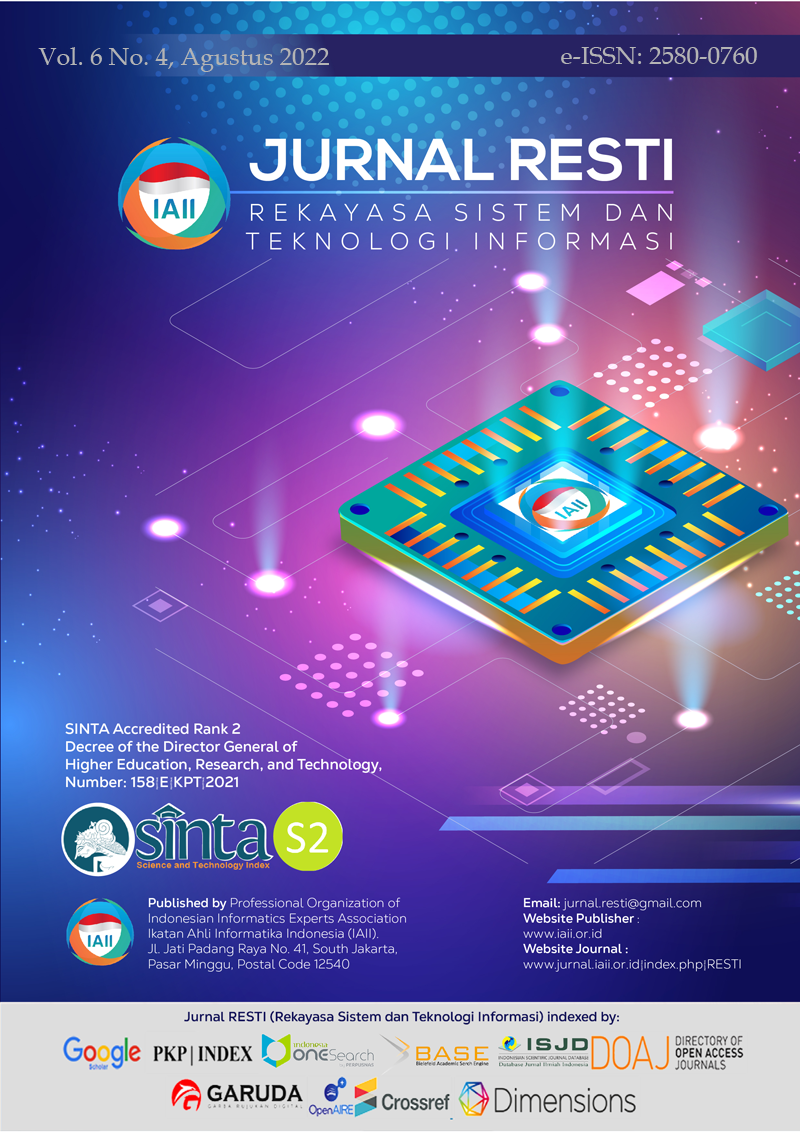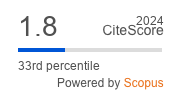System Dynamic Modeling: A Case Study of a Hotel Food Supply Chain
Abstract
However, a closer examination reveals that many firms are battling inventory bottleneck as the covid pandemic spike in demand converges, which results in unpredictability and unstable sale fluctuation. This situation forced the hotel industry to find a balance between fulfilling demand and inventory turnover, which is impossible to predict accurately. Therefore, this research aims to combine system dynamics modelling with a hotel food supply chain system to solve the unpredictability of supply chain dynamics. In addition, The Causal Loop Diagram (CLD) and Stock and Flow Diagram (SFD) are used in this study to model the complexity of the case study supply chain, with an objective model to minimize the instability of inventory turnover and to stabilize the sales movement. This study proposes five policy scenario simulations where standard deviation (SD) and Standard of Error (SE) are used as the decision-making parameters. The simulation result suggests that the fifth scenario provides the highest SD (49.484) and the lowest SE (6.336). Therefore, controlling the customer response time variable to a maximum of 25 minutes and the menu unavailability variable to 15 occurrences per week will result in higher stability of the case study inventory turnover.
Downloads
References
A. Khan, S. Bibi, A. Lorenzo, J. Lyu, and Z. U. Babar, “Tourism and development in developing economies: A policy implication perspective,” Sustain., vol. 12, no. 4, pp. 1–19, 2020, doi: 10.3390/su12041618.
H. Tsai, H. Song, and K. K. F. Wong, “Tourism and hotel competitiveness research,” J. Travel Tour. Mark., vol. 26, no. 5–6, pp. 522–546, 2009, doi: 10.1080/10548400903163079.
C. K. Odoom, “Logistics and Supply Chain Management in the Hotel Industry : Impact on Hotel Performance In Service Delivery,” University of Nevada, 2012. doi: 10.34917/3253876.
H. S. Sethu, “Supply Chain Management in Hospitality Industry-An Overview,” J. Hosp. Appl. Res., vol. 2, no. 2, p. 33, 2007.
M. Mackenzie and B. Chan, Manual on Module II Introduction to Hospitality. Hong Kong: The Government of the Hong Kong Special Administrative Region All, 2013.
K. A. Fantazy, V. Kumar, and U. Kumar, “Supply management practices and performance in the Canadian hospitality industry,” Int. J. Hosp. Manag., vol. 29, no. 4, pp. 685–693, 2010, doi: 10.1016/j.ijhm.2010.02.001.
S. Kumar and A. Nigmatullin, “A system dynamics analysis of food supply chains - Case study with non-perishable products,” Simul. Model. Pract. Theory, vol. 19, no. 10, pp. 2151–2168, 2011, doi: 10.1016/j.simpat.2011.06.006.
A. N. Raghavendra and G. Nijaguna, “Supply Chain Management in Hospitality Industry: Impact on Service Quality in McDonald’s Restaurants, Bangalore,” Glob. J. Commer. Manag. Perspect., vol. 4, no. 2, pp. 22–29, 2015.
C. A. Nguegan Nguegan and C. Mafini, “Supply Chain Management Problems in the Food Processing Industry: Implications for Business Performance,” Acta Commer., vol. 17, no. 1, pp. 1–15, 2017, doi: 10.4102/ac.v17i1.485.
V. Milovanović, “the Covid-19 Pandemic Effects on the Hotel Industry,” in Tourism Challenges Amid Covid-19, 2021, no. June, pp. 570–587. doi: 10.52370/tisc21570vm.
J. M. Rodríguez-Antón and M. D. M. Alonso-Almeida, “COVID-19 impacts and recovery strategies: The case of the hospitality industry in Spain,” Sustain., vol. 12, no. 20, pp. 1–17, 2020, doi: 10.3390/su12208599.
F. Hao, Q. Xiao, and K. Chon, “COVID-19 and China’s Hotel Industry: Impacts, a Disaster Management Framework, and Post-Pandemic Agenda,” Int. J. Hosp. Manag., vol. 90, pp. 1–11, 2020, doi: 10.1016/j.ijhm.2020.102636.
M. Abou Kamar, “The Impact of COVID-19 Disruptions on Hotel Supply Chain Resilience and Robustness: The Role of Risk Alleviation Practices,” J. Assoc. Arab Univ. Tour. Hosp., vol. 22, no. 1, pp. 132–152, 2022, doi: 10.21608/jaauth.2022.111284.1279.
J. Afshar, N. Sadeghiamirshahidi, A. R. Firouzi, S. Shariatmadari, and S. A. H. bin Syed Hassan, “System dynamics analysis of a blood supply chain system,” Appl. Mech. Mater., vol. 510, no. March, pp. 150–155, 2014, doi: 10.4028/www.scientific.net/AMM.510.150.
J. Duggan, “An Introduction to System Dynamics,” in System Dynamics Modeling with R, no. October, Cham: Springer International Publishing, 2016, pp. 1–24. doi: 10.1007/978-3-319-34043-2_1.
R. R. P. Langroodi and M. Amiri, “A System Dynamics Modeling Approach for a Multi-Level, Multi-Product, Multi-Region Supply Chain Under Demand uncertainty,” Expert Syst. Appl., vol. 51, no. 2016, pp. 231–244, 2016, doi: 10.1016/j.eswa.2015.12.043.
M. Yearworth, “A Brief Introduction to System Dynamics Modelling,” University of Bristol, no. October. pp. 1–15, 2014. doi: 10.7551/mitpress/8179.001.0001.
P. D. Sentia, Andriansyah, R. D. Lufika, and M. J. Satria, “The planning of iron sand inventory with System Dynamic Approach,” in IOP Conference Series: Materials Science and Engineering, 2020, vol. 931, no. 1, p. 012015. doi: 10.1088/1757-899X/931/1/012015.
A. Andriansyah, A. Rahmi, and I. Ilyas, “Using System Dynamic Model for Predicting Inventory of Rice Necessity,” in Journal of Physics: Conference Series, 2020, vol. 1569, no. 2, p. 022102. doi: 10.1088/1742-6596/1569/2/022102.
D. Curran-Everett, S. Taylor, and K. Kafadar, “Fundamental concepts in statistics: Elucidation and illustration,” J. Appl. Physiol., vol. 85, no. 3, pp. 775–786, 1998, doi: 10.1152/jappl.1998.85.3.775.
D. K. Lee, J. In, and S. Lee, “Standard Deviation and Standard Error of the Mean,” Korean J. Anesthesiol., vol. 68, no. 3, pp. 220–223, 2015, doi: 10.4097/kjae.2015.68.3.220.
D. Curran-Everett, “Explorations in statistics: Standard deviations and standard errors,” Am. J. Physiol. - Adv. Physiol. Educ., vol. 32, no. 3, pp. 203–208, 2008, doi: 10.1152/advan.90123.2008.
P. Georgiadis, D. Vlachos, and E. Iakovou, “A system dynamics modeling framework for the strategic supply chain management of food chains,” J. Food Eng., vol. 70, no. 3, pp. 351–364, 2005, doi: 10.1016/j.jfoodeng.2004.06.030.
Copyright (c) 2022 Jurnal RESTI (Rekayasa Sistem dan Teknologi Informasi)

This work is licensed under a Creative Commons Attribution 4.0 International License.
Copyright in each article belongs to the author
- The author acknowledges that the RESTI Journal (System Engineering and Information Technology) is the first publisher to publish with a license Creative Commons Attribution 4.0 International License.
- Authors can enter writing separately, arrange the non-exclusive distribution of manuscripts that have been published in this journal into other versions (eg sent to the author's institutional repository, publication in a book, etc.), by acknowledging that the manuscript has been published for the first time in the RESTI (Rekayasa Sistem dan Teknologi Informasi) journal ;








